Story at a glance:
- SOM transformed a 1981 Brutalist-style structure into a light-filled, future-ready library for Appleton.
- The library reflects the community’s passion for public services and institutions, establishing it as a beacon for the city.
- Sustainability features include a high-performance enclosure, extensive daylighting, and a geothermal system for HVAC needs.
In March 2024 Jason Fisher signed his name to the last steel beam for the revitalized Appleton Public Library, an action that held unique meaning for him. He’d helped design the library as senior associate principal at SOM and waited for that chance for nearly two decades, as his hometown debated moving, rebuilding, or renovating. When Appleton unanimously selected SOM to design the new library in March 2021, Fisher’s professional and personal lives converged in a milestone he’d long hoped for.
“It was a moment and a project where you just have to pinch yourself because you feel lucky and proud that you’re able to work on it,” Fisher says. He spent the next four years working to preserve and enhance the existing structure to fulfill the Appleton community’s vision.
Repurposing a Civic Anchor
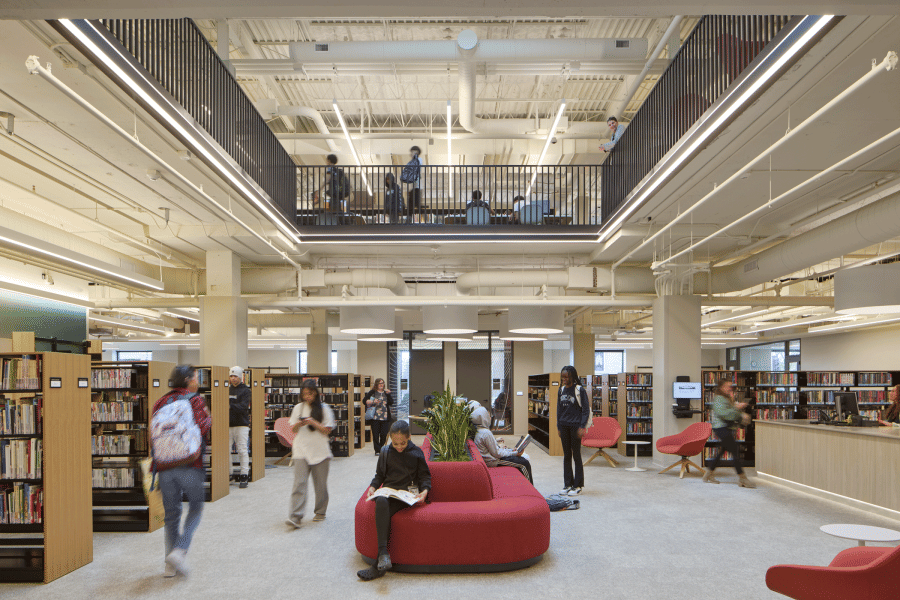
Each floor offers easy access to computers, comfortable seating, and rooms for a range of activities. Photo by Dave Burk, courtesy of SOM
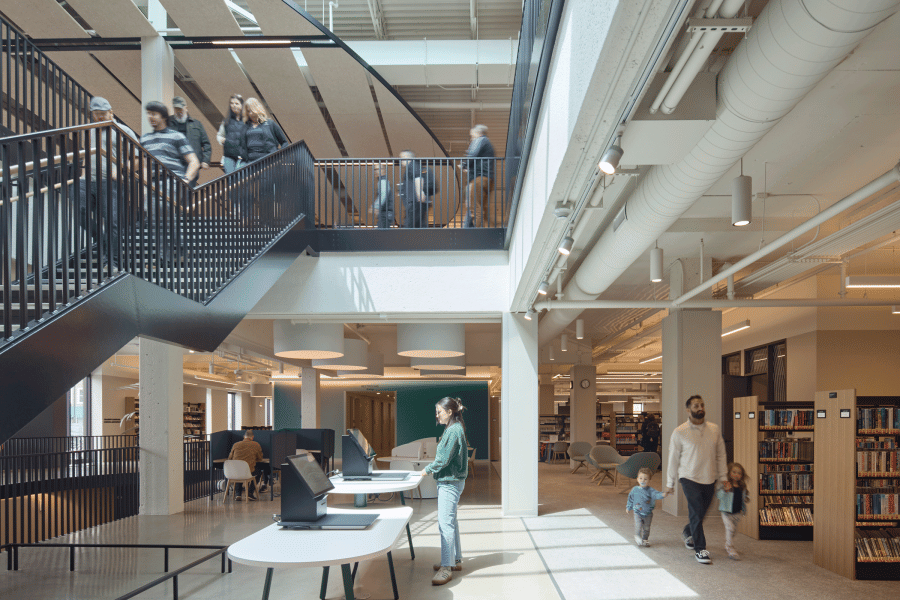
Staggered openings carved into the floor plates and connected vertically by open staircases link the children’s area on the lower level, teen and adult collections on the first floor, and nonfiction and the community gathering space on the upper level. Photo by Dave Burk, courtesy of SOM
Built in 1981 and expanded in 1996, the previous Brutalist-style brick library didn’t meet the requirements of modern life or offer a space that could welcome several hundred people for community gatherings. Small windows, dark interiors, and deep floor plates marked the structure, but SOM saw possibilities in the robust construction.
“One of the major decisions we were fully on-board with was reusing the building,” Fisher says. “From a simple carbon standpoint it’s the most sustainable thing you can do.” Reimagining and revitalizing the building also fit SOM’s strategic, cost-effective approach, but then the Covid-19 pandemic sent prices soaring.
“We were designing and bidding in one of the most unprecedented environments of supply chain and material cost increases that I’ve seen in my career,” Fisher says. To face the challenge and keep the budget in check, SOM consulted with the contractor and subs on almost every design detail, no matter how small, to determine how it would impact cost. That eventually turned the design upside down.
“For a long time we had the community space on the ground floor out in front of the building,” Fisher says. “The contractor said, ‘If we build that exact same space on top of the existing building, we’re going to save tons and tons of money because we’re not dealing with new foundations, site work, and infrastructure.” A 7,000-square-foot addition on the top floor now houses the more than 300-person community meeting room, with plans for an egress that may someday lead to a rooftop garden.
Blending Aesthetics & Sustainability
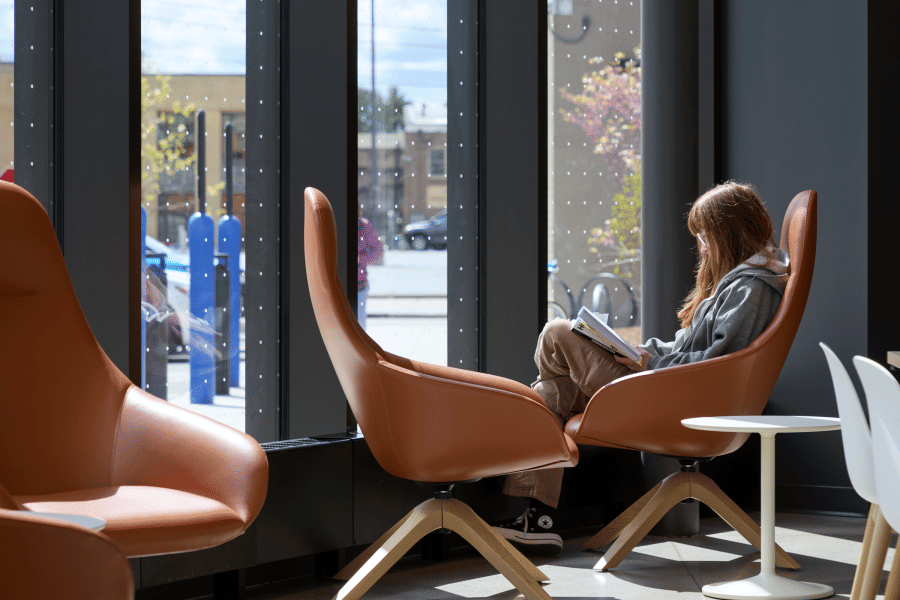
To manage the risk of bird strikes, the team designed a frit pattern for the glass curtain wall that’s almost invisible to the human eye but effective at deterring birds. Simulated acid etch creates a pattern of 3/8-inch dots spaced 4 inches on center. Photo by Dave Burk, courtesy of SOM

Higher ceilings, shorter bookstacks, open sightlines, and daylighting create inviting spaces for learning, programs, and play. Photo by Dave Burk, courtesy of SOM
Despite the financial hurdles, SOM integrated three main dimensions of sustainability—a well-insulated enclosure, extensive daylighting, and energy-efficient heating and cooling—and aligned them with the public’s vision for the building.
The library’s drab enclosure actually proved to be a plus. “No one liked the facade,” Fisher says. “Also, the enclosure did not meet insulation standards for modern buildings.” Today insulated bronze-aluminum panels installed over the existing brick give the structure a lift in aesthetics and thermal comfort. Better sealing at joints and intersections between windows and panels also improves performance.
Insulating glass in the new south-facing oval curtain wall not only conserves energy but lets daylight pour into the library. A frit pattern on the glass that’s almost imperceptible to humans—but visible to avians—helps prevent bird strikes. To flood the space with even more light, SOM carefully expanded the footprint of the once meager vertical windows. “It is sort of like a doctor performing surgery and being careful of what you touch and don’t touch,” Fisher says.
Surgical precision also extends to the addition of two skylights. “We were actually carving openings into the roof and floor slabs and opening up steel joists so we were bringing daylight deep into the space,” Fisher says. Structural engineers performed rigorous calculations to determine the maximum openings possible without disrupting the overall structural system.
Energy efficiency received a major boost from a geothermal system that satisfies 100% of the library’s heating and cooling needs. The parking lot now covers 70 boreholes drilled 400-plus feet deep. The system dramatically reduces the library’s operational energy and costs.
“Very often as designers and engineers we’re trying to convince our clients to spend that little bit of extra money for something that’ll pay off in the future,” Fisher says. But the city council of Appleton was fully behind the geothermal system, which has an estimated 20-year payback. “That makes me proud as a hometown kid that the community cares about those things just as much as I do as a design professional.”
Flexibility & Resilience
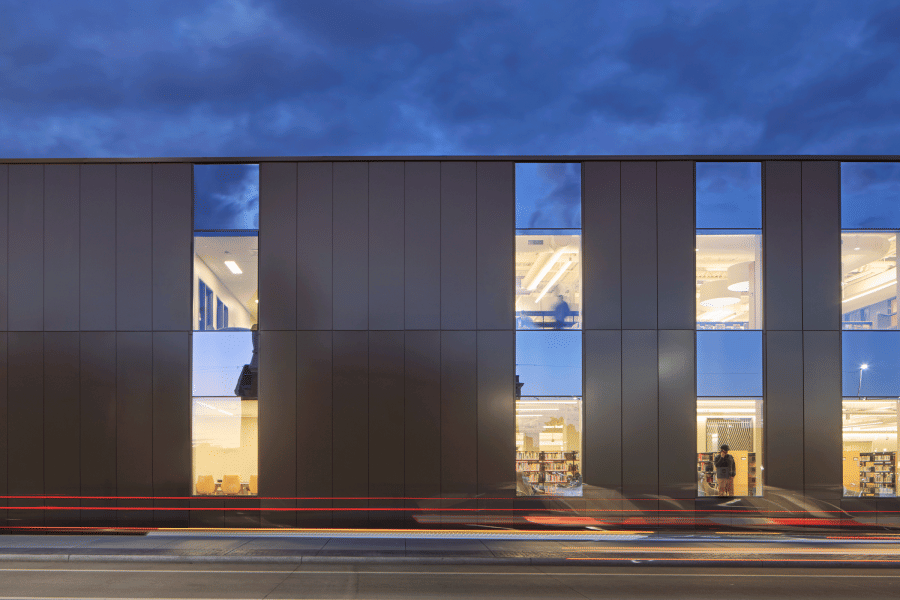
Cladding with high-performance Alucobond PLUS aluminum composite panels in statuary bronze redefined the library’s presence. Backing the panels is 4.5-inch DuPont Thermax Xarmor Polyiso R30 insulation. Energy from the geothermal system now stays in the building at the desired temperature rather than escaping because of poor insulation. Photo by Dave Burk, courtesy of SOM
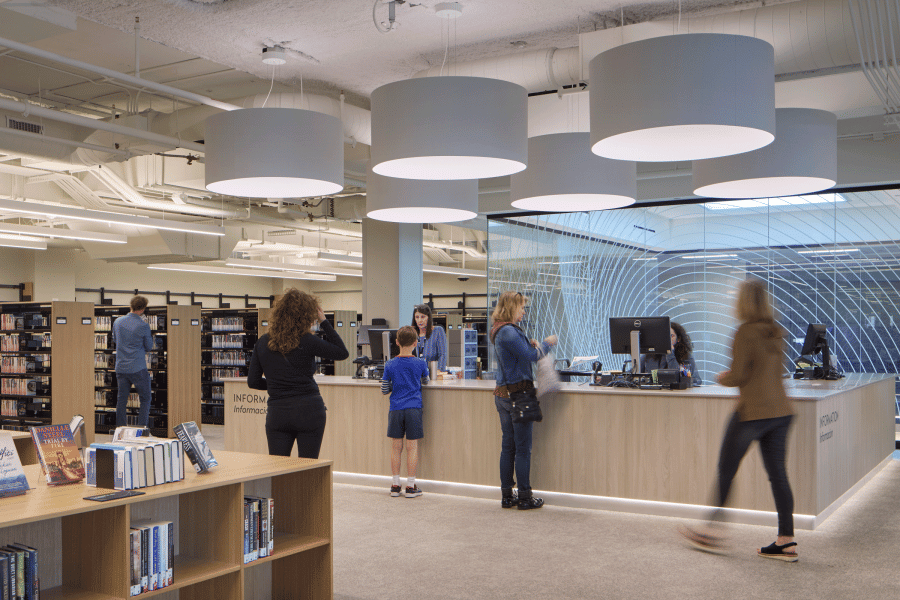
Photo by Dave Burk, courtesy of SOM
Fisher says the architects and engineers held frequent meetings with library staff, user groups, and the public, using tools like virtual reality to “fly” through the design and develop solutions for the current library. But the team also planned for the future. For example, the rooftop can carry solar panels on a ballast system if they’re needed for energy. Electrical running to the parking lot will allow EV chargers.
And who knows what may come next? “I remember using the internet for the first time at the library sitting at a computer and my mind kind of exploding when thinking about all the potential,” Fisher says.
The library stands as a new sustainability benchmark for the city and aligns with SOM’s priorities as well. Fisher says, “I’m just very proud to be from Appleton and to have had the opportunity to work on the project and create a building that the community loves.”


